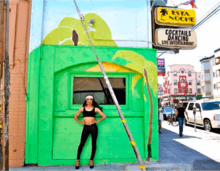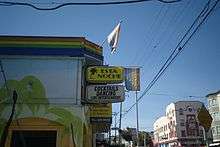Esta Noche (gay bar)

Esta Noche was a gay bar located at 3079 16th & Mission Street in San Francisco, California. It was the first gay Latino bar in San Francisco, and it was attractive to many people from the Latino community because it provided a space to drink, party, engage in hookup culture, organize and perform.[1] The bar first opened in 1979 and was the last Latino bar standing on 16th street by 1997.[1][2]
History
Esta Noche was founded by two openly gay community members, Anthony Lopez and Manuel Quijano.[3]
It is historically placed as the first gay Latino gay bar, and it has significance due to the discrimination LGBT people of color faced in traditionally popular white gay bars especially in the Castro. LGBT people of color often experienced racial slurs, microaggressions, and fetishization as the bars where LGBT people were able to socialize and party were mostly dominated by white men.[2] LGBT people of color were often asked to show multiple forms of identification in these spaces, leading to the creation of Esta Noche.[2] Latino men that would be in those spaces would experience racist remarks as well as being overly fetishized for their culture.[2] The co-founder of the group Gay American Indians (GAI), Randy Burns said that the frustration at this discrimination was also what led his group to form, and members often met at Esta Noche.[4]
Esta Noche also has its roots in the Gay Latino Alliance (GALA), as one of the GALA members sold their house to buy the bar.[2] GALA and Esta Noche worked together in advertising this as the gay Latino bar of the Mission District in San Francisco, which ultimately resurfaced tensions that the organization was dealing with.[2] With the establishment of Esta Noche came the shift of gay Latino representation from GALA to the bar life.[2]
Culture

Esta Noche is defined as a "working-class" bar.[5] The bar served more than people looking for a good time and party, it also provided an important space for those seeking to network with other LGBT people of color. Esta Noche has been defined as a "community organizing center and host to many fundraisers for health clinics, people with AIDS, and other lower-income populations."[6]
The bar gave room for comedy nights where famous Latina comedian Marga Gomez starred.[7] Esta Noche was also famously known for their drag shows; there were sometimes even six shows a week.[8] Another notable person that Esta Noche collaborated with was Diane Felix.[2] People who went to the bar recalled it as a space where people of color, Latinos in particular, could come together and have a space where they would not receive racist discrimination or homophobia.[2][9]
Recognition
Esta Noche was nominated for the SF Pride Marshalls. However, they lost to the Billy DeFrank LGBT Community Center in San Jose, California. They were running against the UCSF Positive Health Program.[6]
Esta Noche was featured in the HBO series Looking for 2 seasons.[10] By the recording in the second season in November 2014, the bar was already closed.[10]
Closing
Esta Noche closed in 2014. The closing was treated as a significant loss to community members, and the bar was generally perceived as another victim of gentrification. Many efforts were made to stop the closing of the bar; for example the "queens of San Francisco drag queens, Heklina and Anna Conda" spearheaded a fundraiser to try to save the venue in May 2014, however were unable to do so.[8] The closing of the bar has been tied to the increasing of property tax in the area which has caused gentrification. Gentrification has also affected many other Latino bars which have had to close.[1][11] By 1997, Esta Noche was the only Latino-owned bar standing in 16th Street.
Bond, another night club, now sits in place of Esta Noche.[12]
See also
References
- 1 2 3 Press, Berkeley Electronic. """'Mira, Yo Soy Boricua y Estoy Aquí': Rafa Negrón's Pan Dulce and the Queer Sonic Latinaje of San Francisco"" by Horacio N Roque Ramirez". works.bepress.com. Retrieved 2016-04-10.
- 1 2 3 4 5 6 7 8 9 Ramírez, Horacio N. Roque (2003-01-01). ""That's My Place!": Negotiating Racial, Sexual, and Gender Politics in San Francisco's Gay Latino Alliance, 1975-1983". Journal of the History of Sexuality. 12 (2): 224–258. JSTOR 3704613.
- ↑ "The Bay Area Reporter Online |". Bay Area Reporter. Retrieved 2016-04-10.
- ↑ "The Bay Area Reporter Online | Gay American Indians
celebrate 40 years". Bay Area Reporter. Retrieved 2016-05-05. - ↑ Ramos, Iván A. (2015-04-03). "The Dirt That Haunts: Looking at Esta Noche". Studies in Gender and Sexuality. 16 (2): 135–136. doi:10.1080/15240657.2015.1038195. ISSN 1524-0657.
- 1 2 "The Bay Area Reporter Online". Bay Area Reporter. Retrieved 2016-04-11.
- ↑ "The Bay Area Reporter Online |". Bay Area Reporter. Retrieved 2016-04-10.
- 1 2 "Drag Queens Say Farewell to Mission Institution Esta Noche". SF Weekly. Retrieved 2016-04-10.
- ↑ Hall, Donald E.; Jagose, Annamarie (2012-06-04). The Routledge Queer Studies Reader. Routledge. ISBN 9781135719449.
- 1 2 "Looking Is The Only Action Esta Noche Is Getting These Days". SF Weekly. Retrieved 2016-04-10.
- ↑ "Esta Noche to Close. Nothing is Sacred.". KQED Pop. Retrieved 2016-04-11.
- ↑ "Home". Bond Bar. Retrieved 2016-04-16.